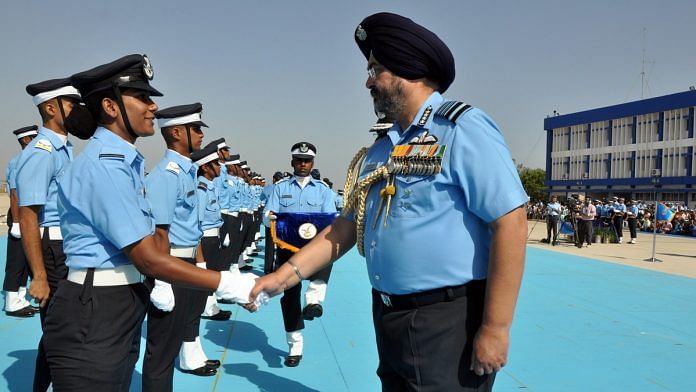New Delhi: Now that Prime Minister Narendra Modi is back from his tour of France, the UAE and Bahrain, the much-anticipated announcement of the next chief of the Indian Air Force is expected soon.
While the PM had taken a decision on the new cabinet secretary and defence secretary before he left, the IAF chief appointment is still pending.
Current Air Chief Marshal B.S. Dhanoa is set to retire on 30 September, and his successor is expected to have a tough task at hand as the IAF is set to see some major reforms in the coming months, both in terms of strategy and systems, in the face of a depleting fighter squadron strength.
Officers in contention
There has been much speculation inside the force on who will be the new chief, with the main race seen as between Air Marshal B. Suresh and Air Marshal R. Nambiar.
Suresh, the Air Officer Commanding-in-Chief (AoC-in-C) of the Thiruvananthapuram-based Southern Air Command, is the senior-most officer in the IAF after Dhanoa. Nambiar, meanwhile, is the AOC-in-C of the crucial Western Air Command, which oversees all aerial operations along the borders with Pakistan.
Sources said both officers are competent and everything would depend on the decision of the government.
They also said the name of another officer, Air Marshal Rakesh Bhadauria, cannot be ruled out. Bhadauria is currently the Vice Chief of Air Staff, but his name was not part of the file initially sent to the PMO for clearance.
Air Marshal Bhadauria’s initials are featured on the tail numbers of the Rafale trainer jets, because he, as Deputy Chief, was the key man in India’s negotiations with the French government and Dassault Aviation.
He is set to retire on 30 September, the same day as chief Dhanoa, but there is a precedent for two men retiring on the same day to have been IAF chiefs — Air Marshal N.C. Suri became the Chief of Air Staff after Air Chief Marshal S.K. Mehra, despite both retiring on 31 July, 1991. This was possible because Mehra demitted office in the forenoon, thus enabling Suri to become chief.
Also read: Senior IAF officer expresses concern on Modi govt’s procedure to appoint next air chief
Reforms will mean tough task ahead
Sources said whoever becomes the new chief will have a tough task at hand as the government tries to streamline the force.
The Balakot strike and the subsequent air battle on 27 February have changed a lot of dynamics as far as the IAF is concerned, sources said, as they established that weapons systems including missiles play a major role and can decide the outcome of a conflict.
There is a growing view in the government and the force that rather than focusing on pure numbers in terms of squadron strength, more thought should be given to the capability of the systems.
Currently, the IAF has a fighter squadron strength of 30, as against a sanctioned strength of 42. However, the 30 squadrons include several ageing aircraft, including MiG-21s and Jaguars.
“In basic terms, one squadron of Rafale with its full weapon system is equal to two squadrons of the Sukhoi Su-30 MKI. Where once India would have deployed two Su-30 MKIs for a single F-16 of Pakistan, the enemy will now have to deploy two F-16s for a single Rafale,” a source said.
Giving the example of Pakistan, a second source said the IAF has the superiority in numbers over the Pakistan Air Force (PAF) in the current context. However, this only becomes an advantage when the battle is spread over the entire border.
“When it becomes limited to a particular sector, the PAF and the IAF are on equal footing, and at times, the enemy is better positioned because of the F-16s,” another source said.
Another big focus area of the government is jointness among the three services, and the eventual long-term plan to create theatre commands.
For this to happen, the IAF has to eventually come on board, but it has been reluctant so far.
Also read: Never mind Balakot, IAF is worse off than Pakistan Air Force on pilot strength




At that level seniority has no role its over all exp and capability which matters .
Why do we compare forces strength with Pak and feel happy that we are better .pak is a small country , is there any logic to compare with Pak. We need to compare with China where we stand ? Do we have target to reduce below Pak strength ? It’s really ridiculous.
Dhanoa was a disaster….Feb 27th was a day of shame for IAF !!!!
Lol which world you fool live. Fake PR by pakis
The principle of seniority has been sacrosanct. It has served the forces well.